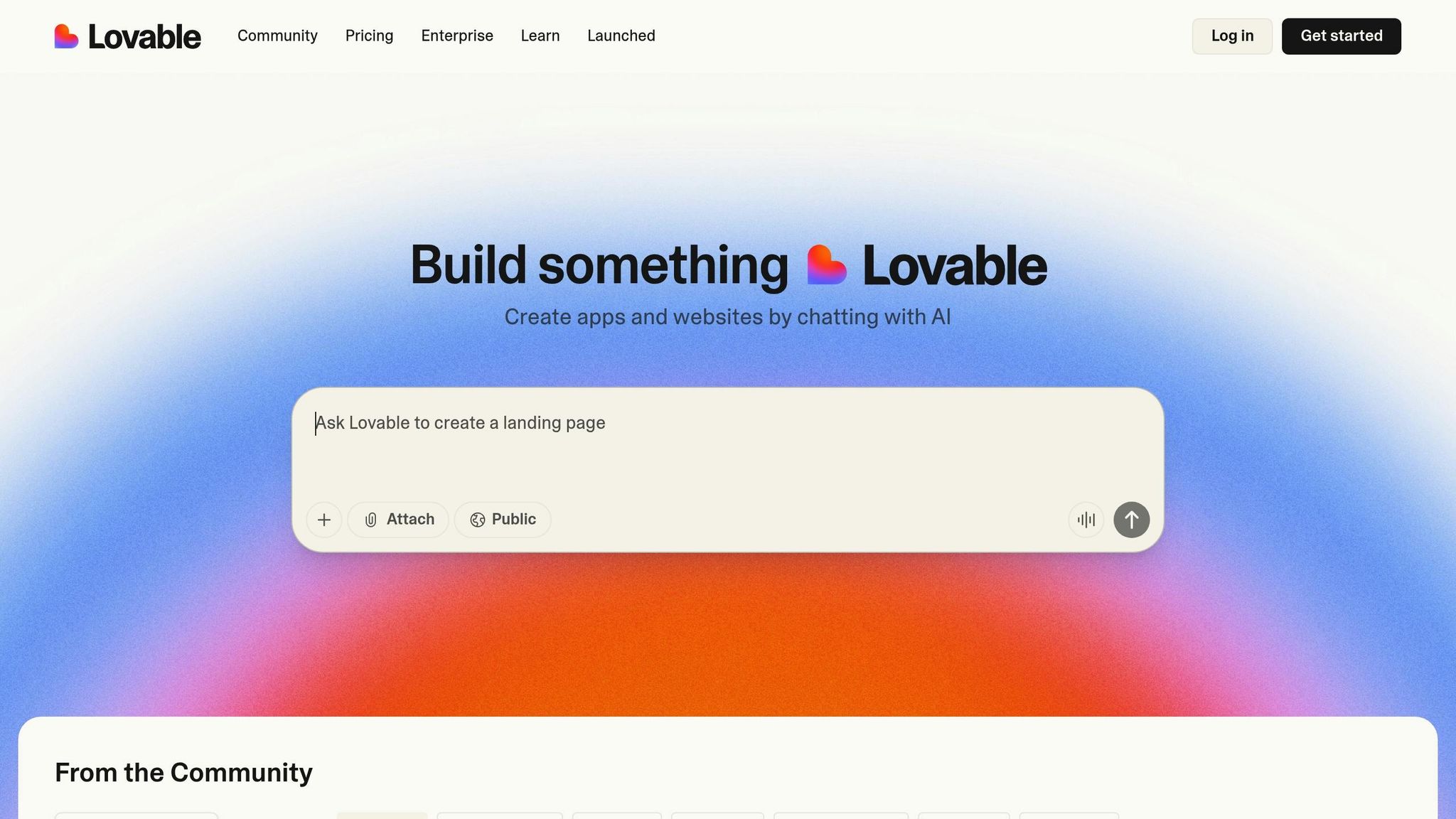When working with Lovable's AI to build apps, common mistakes can derail your progress. Here's how to avoid them:
- Lack of Planning: Jumping in without a clear plan leads to vague results and wasted effort. Write down user goals, features, workflows, and technical needs before starting.
- Testing on Live Data: This risks irreversible errors like data loss. Always use separate test environments with dummy data to keep your live systems safe.
- Messy Code: Unchecked AI-generated code can become inefficient over time. Regularly review and clean up unused functions, duplicates, and redundant queries.
- Confusing Prompts: Vague or overloaded instructions confuse the AI. Break tasks into small, specific prompts for better results.
- Overusing Vibe Coding: While great for interfaces, Lovable.dev struggles with complex backend tasks. Use specialized tools for advanced workflows and integrations.
Everything I wish I knew before using Lovable (tips & tricks)
Mistake 1: Starting Without a Plan
One of the easiest pitfalls in vibe coding is jumping straight into development without a clear idea of what you're building. Giving vague prompts like "make me a social media app" often leads to wasted time and effort. Why? Because the AI thrives on precise instructions. Without them, you’ll find yourself revising endlessly, creating a patchwork codebase that technically works but falls short of its intended purpose.
The planning phase isn’t just about jotting down a wish list of features. It’s about digging deeper: Who is your app for? What specific problem does it solve? How will you measure its success? Skipping this step is like asking the AI to read your mind - it’s just not going to happen. A solid, written plan transforms abstract ideas into actionable steps and ensures the development process stays on track.
Best Practice: Write Down Your Plan
Take the time to document your vision. This includes user personas, feature specifications, workflows, and technical requirements. Tools like Lovable.dev or a simple /docs folder work great for this. Having a written plan not only prevents scope creep but also acts as your guiding star throughout the project.
When you’re knee-deep in coding and start questioning your original direction, these documents will help you recalibrate. And if new ideas arise mid-development, you can evaluate them against your initial plan before deciding whether to include them, rather than derailing your progress with impulsive changes.
Mistake 2: Testing on Live Data
Using real, production data during development might seem like a convenient shortcut, but one small mistake can lead to irreversible damage. Developers often fall into this trap, underestimating the risks involved. However, the potential consequences - like accidentally deleting or corrupting critical databases - can be catastrophic. These errors could wipe out years of work and seriously damage customer trust.
When working with tools like Lovable.dev, the AI can generate code rapidly, but it doesn’t differentiate between a safe testing environment and your live data. Frequent tweaks and experiments in such scenarios amplify the chances of something going wrong. Whether it’s modifying user accounts, running database operations, or processing data, mistakes are more likely to occur during fast-paced development cycles. Even if your app seems to perform well with live data during testing, that doesn’t mean it’s ready for production. This is why keeping development and production systems separate is non-negotiable.
Solution: Create Test Environments
Having separate environments for development is not just a luxury - it’s a necessity for any serious project using Lovable.dev. Your development setup should closely resemble your production environment but use entirely isolated databases, user accounts, and service connections.
Start by creating a dedicated development database filled with sample data that imitates your real information but poses no risk. For example, if you’re building an e-commerce application, populate it with fake products, dummy customers, and mock transactions. If it’s a social media platform, include test user profiles and sample posts. This approach lets you test realistically while keeping your live data safe.
Lovable.dev makes this process easier with its database management tools, allowing you to switch between database connections and maintain separate configurations for each environment. Treat these environments as completely independent systems - what happens in development should stay in development.
For added safety, consider setting up multiple test environments: one for active development where changes and experiments happen frequently, another for staging to test more stable versions of your application, and finally, the production environment, which remains completely separate. This layered setup provides multiple safety nets, reducing the risk of accidental errors affecting live systems.
Best Practice: Set Up Safety Protocols
Creating test environments is a great start, but you also need strict protocols to ensure you never accidentally tamper with live data. Clear, consistent rules should guide your development process and become second nature to your team.
One effective strategy is color-coding your environments in your tools. For instance, assign red for production, yellow for staging, and green for development. This visual cue can help avoid costly mistakes when switching between systems.
Additionally, implement safeguards for database connections. These might include requiring explicit confirmation before connecting to production systems, using separate credentials for production, or even enforcing additional authentication steps for critical changes. Some teams go a step further by requiring approval from another team member before making significant updates to live systems.
Finally, establish a deployment checklist. This should include verifying that all database connections, API keys, and test data references are correctly configured or removed before deploying code to production. Document these protocols and ensure every team member is familiar with them. Following these steps consistently can be the difference between smooth operations and a data disaster.
Mistake 3: Never Cleaning Up Code
AI-generated code from Lovable.dev might start strong, but without regular upkeep, it can lead to issues down the road. Every new feature or bug fix adds layers to your codebase. Over time, this can result in unused functions, duplicate components, and inefficient code paths that bog down your app's performance.
If left unchecked, this clutter can make your app sluggish and harder to maintain. For instance, AI might implement similar features in slightly different ways or duplicate styles across components. Regular cleanup helps you catch and address these inconsistencies, keeping your codebase efficient and easy to work with.
Solution: Schedule Code Reviews
Make time for routine code reviews to keep your AI-generated code in check. These reviews aren't just about squashing bugs - they're about optimizing your app. Look for things like redundant functions, repeated patterns for data loading, or unused imports. Clear out commented-out code and consolidate similar functions to streamline your codebase.
It's also important to review database queries and API calls. Watch for unnecessary connections or repeated requests that could strain your app's resources. A good checklist can help you stay on top of unused code, function consolidation, and database efficiency. Think of it like regular maintenance for your car - a little effort now can save you from bigger headaches later.
Best Practice: Improve Generated Code
Once you've reviewed the code, take it a step further by refining it for clarity and performance. Treat AI-generated code as a starting point, not the final product. Begin by renaming vague variables and adding comments to explain tricky logic. This makes your code easier to understand and work with.
Next, organize your code into logical components. If one component is doing too much, break it into smaller, reusable pieces. This not only simplifies maintenance but also makes future updates smoother.
Don't forget to add loading states and robust error handling to enhance your app's performance. These small, incremental improvements ensure your app stays efficient and scalable as it evolves.
Mistake 4: Using Confusing Prompts
When working with Lovable.dev's AI, clear instructions are everything. Vague prompts like "make it better" or "add some features" leave the AI guessing about your intentions. Similarly, combining too many requests in a single prompt often results in incomplete features or an app that doesn't match your vision.
The issue gets worse when prompts include technical jargon or conflicting instructions. AI performs best when it has a clear understanding of your goals. Confusing or overly complex prompts can lead to apps with missing features, clunky interfaces, or disconnected functionality.
If you were to ask a human developer to "create something cool for users to interact with", they'd likely ask for more details. In contrast, AI takes your input at face value, which makes breaking your project into smaller, focused tasks even more important.
Solution: Break Projects into Small Parts
To avoid confusion, break your project into smaller, well-defined tasks. Focus on one feature at a time and ensure it's working as intended before moving on to the next. This step-by-step approach makes it easier to pinpoint issues early and gives you more control over the final product.
For instance, instead of saying, "build a social media app with posts, comments, and user profiles", tackle one feature at a time. Start by asking the AI to create a user registration system. Once that's functional, move on to a basic post creation feature. After that, add a feature to view posts, and so on.
Each prompt should target a specific functionality with clear requirements. For example, instead of saying, "add a dashboard", specify: "create a dashboard that displays the user's name, total posts, and recent activity from the last 7 days." This level of precision helps the AI deliver what you need and minimizes surprises.
By working in small increments, you can thoroughly test each feature before adding more complexity. This approach also makes it easier to tweak and improve individual parts without reworking large sections of your app.
Best Practice: Test Your Instructions
Experiment with different ways of phrasing your prompts to discover what works best. Lovable.dev's chat interface allows you to refine your instructions based on how the AI responds.
After issuing a prompt, review the AI's output immediately. If it’s not quite right, don’t settle - try rephrasing your request with more specific details. Over time, you'll notice patterns in the types of instructions that produce better results. Use these patterns to guide future prompts.
You can also attach files to your messages for added context [1]. For example, sharing wireframes, design mockups, or examples of similar features can help the AI better understand your vision and deliver results that align more closely with your expectations.
Keep track of prompts that consistently work well for specific tasks. For instance, if you find a particular way of requesting user authentication that yields great results, save that phrasing for future projects. Building a personal library of effective prompts will not only speed up your development process but also improve the quality of your apps over time.
Mistake 5: Using Vibe Coding for Everything
Lovable.dev is fantastic for creating user interfaces and managing basic interactions. But relying on it as a one-size-fits-all solution for every development task can complicate your project. Some developers fall into the trap of thinking vibe coding can handle everything, but when it comes to more intricate workflows or complex integrations, this approach can quickly become a headache.
While Lovable.dev shines in delivering clean and functional interfaces, tasks like advanced backend logic, detailed API integrations, or specialized data processing are better suited for dedicated tools. Trying to cram all these functions into a single app can lead to cluttered, hard-to-maintain code. Instead, delegating these complex tasks to purpose-built tools helps keep your app streamlined and manageable.
Pairing Lovable.dev with specialized solutions ensures a more balanced and efficient project architecture.
Solution: Add Specialized Automation Workflows
Use Lovable.dev alongside tools designed for handling complex processes. For instance, if your app requires large-scale data processing or advanced logic, consider setting up a dedicated automation workflow. This could involve your app sending data via webhooks to an external tool designed for heavy-duty processing, which then returns the results. This approach keeps your core interface clean and focused while offloading the heavy lifting to systems built for it.
Best Practice: Use the Right Tools for the Job
Successful projects treat Lovable.dev as the go-to solution for frontend tasks, like user registration, form handling, and data display. For more advanced needs - like data transformations or multi-step integrations - dedicated workflows and tools should take the lead. This division of labor not only makes your app easier to maintain and scale but also ensures each tool is used where it performs best. By playing to each tool's strengths, you’ll create a more efficient and sustainable application.
Conclusion: Build Better Apps with Lovable.dev

Lovable.dev gives you the tools to create apps through straightforward AI-driven interactions. Whether you're working on a quick prototype or a full-scale business solution, the platform adapts to your specific needs, helping you tackle real-world challenges with confidence.
By steering clear of common missteps like poor planning, risky testing, messy code, unclear prompts, or relying too much on intuition, you set your projects up for success. Lovable.dev’s interactive features, such as file attachment for easy refinements, make it simple to iterate and improve. When paired with thoughtful planning and tailored workflows, these practices help you build apps that truly deliver.
Keep your focus on structured planning, safe testing, consistent code maintenance, clear communication, and using the right tools for the job. With this approach, you can bring your app ideas to life and create something users will love.
FAQs
What’s the best way to plan my project with Lovable.dev before starting development?
To kick off your project with Lovable.dev on the right foot, it’s crucial to invest time in thoughtful planning before jumping into development. Start by outlining what you want your app to achieve and break that vision into smaller, manageable tasks. A framework like SPARC by Reuven Cohen can be a useful tool to structure your ideas and steer clear of common pitfalls, like making your project too complex or unclear.
Also, think about how external services or AI features will fit into your app. For instance, if your app needs to process large datasets or use AI for recommendations, you might want to handle these tasks through workflows or external tools, then link them to your app. This approach keeps your project more focused and simplifies the development process.
What are the best practices for avoiding common mistakes when creating apps with Lovable.dev?
To make the most of Lovable.dev and steer clear of common pitfalls, keep these tips in mind:
- Plan before diving in: Before you start building, map out your app's features and workflows. Frameworks like SPARC can help you create a well-structured and purposeful design.
- Use test environments: Never experiment with live data. Testing your changes in a controlled environment can prevent costly errors, like accidentally deleting important information.
- Refactor often: Regularly revisit and clean up your code to keep your app efficient and manageable. Skipping this step can lead to cluttered, hard-to-maintain projects.
- Provide clear context for AI: When working with AI or large language models (LLMs), ensure your input is well-structured and relevant. Ambiguous or poorly organized data can lead to subpar performance.
- Simplify complex tasks with external tools: For intricate features or AI-heavy processes, consider using external workflow automation platforms. By connecting these tools to your app through webhooks, you can streamline operations and reduce complexity.
By sticking to these practices, you'll reduce errors and build apps that are both efficient and reliable.
What are the best practices to ensure apps built with Lovable.dev stay efficient and scalable?
To keep your Lovable.dev apps running smoothly and ready to grow, steer clear of common mistakes. For instance, avoid working directly with live data without having backups in place - this can lead to serious issues like accidentally deleting important information. It’s always a good idea to plan your app’s structure ahead of time. Using frameworks like SPARC can help keep things organized and prevent your design from becoming overly complicated or cluttered.
Another tip: don’t depend entirely on "vibe coding" for every task. When dealing with processes that require heavy external integrations or AI-powered features, tools like n8n workflows can be a game-changer. They allow you to handle these operations separately and connect them to your app using webhooks, keeping your app streamlined and efficient. Lastly, make it a habit to refactor your code regularly. This ensures your codebase stays clean, easy to understand, and free from performance bottlenecks as your app grows and evolves.


